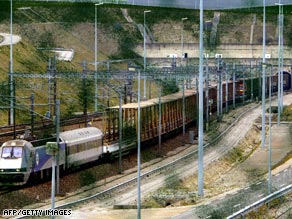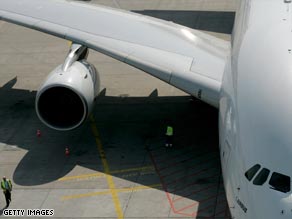LONDON, England (CNN) -- Lorry drivers said Friday they felt lucky to be alive after escaping from a major blaze on board a train deep underneath the English Channel.

Truckers alight from a special emergency train as they are evacuated from the Channel tunnel.

A freight train emerges from the Channel tunnel in this file photo.
They were speaking as firefighters continued to tackle the fire, which broke out Thursday near the French end of the 50-kilometer (30-mile) tunnel, also called the "Chunnel," injuring 14 people and causing widespread disruption to travelers.
Patrick Lejein, 50, from Bruges in Belgium, said he and other truckers had to smash windows to escape from the train after the doors jammed shut.
"There was a burning lorry and a series of explosions -- about 20 of them," he told Le Parisien newspaper.
"Everything was exploding around us -- tyres, fuel tanks, and then there was this smoke which prevented us from seeing and breathing properly."
Lejein added: "The door of our carriage was locked, impossible to open. We had to save ourselves by smashing a window with a hammer.
"We escaped from the train through this window. It was at that moment that we panicked the most. We imagined ourselves trapped there. We really were very lucky."
French firefighters said on Friday morning they had finally extinguished the "major part" of the blaze.
Three hundred firefighters -- 100 British and 200 French -- fought the fire overnight and eventually brought it under control, the UK's Press Association reported.
Traffic in the Channel tunnel remained halted. Eurostar, which operates passenger trains through the tunnel, said it did not expect to run any services between England and France on Friday.
Eurotunnel, the tunnel's operator, said the French and British governments will assess whether it is safe to travel once the fire has been put out.
Eurostar said all passengers who had booked train tickets for Friday can exchange them for travel on a later date or get a refund. Passengers with tickets for the weekend should continue checking Eurostar's Web site for updates, the company said. ![]() Watch options for stranded travelers »
Watch options for stranded travelers »
Jacques Gounon, chairman and chief executive of the French arm of Eurotunnel, said Friday the fire was accidental.
Jacques Gounon, chief executive of Eurotunnel, which operates the tunnel, told The Associated Press he had no reason to believe the fire could have been "criminal."
The fire started on a shuttle train carrying freight about 11 kilometers (7 miles) from the French end of the tunnel. No passenger trains were going through the tunnel at the time of the fire.
Fourteen people were injured in the fire, including six who suffered from smoke inhalation. It was among the most serious incidents in the history of the tunnel, which opened to passengers in 1994.
Thirty-two people were evacuated through a central service tunnel that runs between the east and west tubes, according to fire officials in Kent, on the English side of the tunnel.
Eurotunnel authorities suspended services in both directions to allow emergency vehicles to get to the fire.
Closure of the tunnel will also affect thousands of trucks that transport goods between England and France every day.
The $15 billion undersea tunnel opened in 1994 and has drastically reduced land/sea travel time between Great Britain and mainland Europe.
A massive fire broke out inside the tunnel in November 1996, causing structural damage but no serious injuries. A truck on a Eurotunnel shuttle caught fire before the train entered the tunnel, and the fire spread to nearby cars.
That fire was caused by the vehicle's traction system and had "nothing to do with the cargo or the people," according to Colin Brown, director of engineering at the Institute of Mechanical Engineers.
